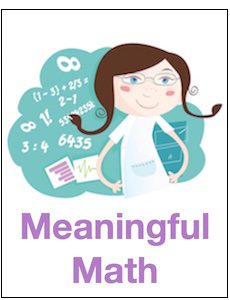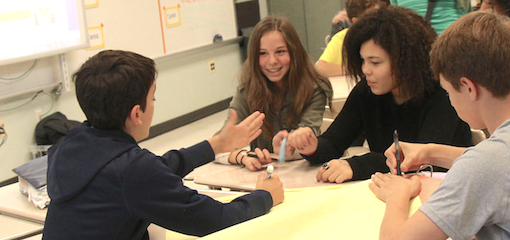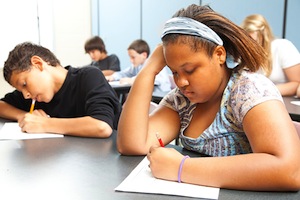Get Started Right Now with Math Class Norms
A MiddleWeb Blog
 I know it’s that time of year because I have started having my back-to-school nightmares – you know the ones where the students are sitting in your room and you don’t have any plans at all?
I know it’s that time of year because I have started having my back-to-school nightmares – you know the ones where the students are sitting in your room and you don’t have any plans at all?
Even after 13 years I get nervous and excited in early August as our Alabama school-start approaches. Our professional development began August 1st and students will arrive later this week. I’m now in the midst of finalizing plans, and I’m getting some real help this time around from author and math coach Geoff Krall.
I read and reviewed Krall’s Necessary Conditions last year, and I was blown away by the great suggestions, activities, and templates. In case you’re not familiar with the book, Necessary Conditions provides a “coherent approach to secondary math pedagogy.” (You can read my post about it here.)
Krall focuses on three areas for math success: academic safety, quality tasks, and effective facilitation. If I could recommend only one math book to read for professional development, this would be the one.
The only negative for me was that I read it during the middle of the school year and I could not fully implement some of the great suggestions found in the book, specifically those related to classroom norms.
So I’m excited to start out this school year using Necessary Conditions, and I want to share with you how I plan to implement Geoff’s advice from the very beginning.
Establishing Good Habits from the Start: Making Group Work Productive and Meaningful
By the time I read the book last spring, my students were already set in their habits and I had not done a good job setting classroom norms that supported productive and meaningful group work. In other words, some of the norms in my classroom were not the ones that I wanted.
I plan to fix that this year. There is a chapter in Necessary Conditions called Norms, Structures, and Routines (chapter 6), and much of the discussion deals with how to establish norms (routines, structures) for group work that will make it productive – and minimize some of the negative outcomes we worry about when we form groups.
Krall has so many good suggestions that I found personally helpful. For example, I had a problem last year with students wanting to “divide up” the work I gave them. They would break the problems up and one student would work the evens and the other student the odds, or something similar.
I had just assumed they would both work on number one, get an answer, discuss it, then move on to number two. It didn’t occur to me that I needed to instruct them on this.
Well, one of the classroom norms Krall suggests is “same problem, same time,” which means each group member is working on the same problem at the same time and the group doesn’t move on until each member is ready. You can be sure that I will practice this norm repeatedly with my students in the first few weeks of school.
On that point, Krall reminds us that students need to be explicitly taught the norms we desire in our classroom. I love this quote from the book: “you can’t expect that which you don’t teach.” It was unreasonable for me to expect my students to just know what to do. It is also unreasonable for me to expect behaviors from students when I don’t give them time to practice those behaviors.
Based on my experiences and some of the difficulties I encountered with group work last year, I have chosen four Norms that I want to start practicing from day one with my students.
Norm #1: Same problem, same time.
Norm #2: Ask the group for help and clarification when needed.
Norm #3: All heads in, all feet in.
Norm #4: Everyone must contribute.
I plan to laminate these and place them on their desks when doing group work. The first few weeks of school, and later as necessary, will be spent reinforcing, discussing and reviewing these norms. (These norms are taken from Appendix E of Necessary Conditions.)
If you struggle to come up with your norms for your classroom (like I usually do), Appendix F at the back of the book has several suggestions.
Academic Safety: Determining Student Attitudes and Mindsets Related to Mathematics
Necessary Conditions makes the important connection between a student’s attitude toward math and academic safety. I want my students to feel my classroom is a safe and comfortable place to learn, and to do that I need to know how they feel about “math and themselves” (page 247), which is why I always give my students a survey at the beginning of the year. This year I am so excited to use the one included in the back of the book.
Krall’s survey has six short-answer questions and ten agree/disagree statements. The survey should take about fifteen minutes. One of the questions is “Do you think you are smart in math? Why or why not?” Another question is “What would you like to do more of in math class?” I cannot wait to read the responses!
I plan to put the survey in Google Forms. The author suggests giving the surveys anonymously so that students will answer honestly. I went back and forth on this because I would like to know how each student responds. However, I ended putting a place for their name but making it completely optional so if a student wants to respond anonymously they can.
Krall also encourages teachers to check in with students throughout the year to see “how they are experiencing math and how they view themselves as mathematicians” (page 246). I have not done that in the past. Usually I give some type of survey at the beginning of the year, but I do not check in to see how their attitudes might have changed over the course of our time together.
This year I will probably give the survey to my students again before the Christmas break and possibly at the end of the school year. I also plan to use some of the questions as bellringers (warm-ups) and also as prompts for whole class discussions.
Final Thoughts
I am so excited to start the year off using Geoff Krall’s book! Hopefully I can lay the right foundation with my students so that I can implement more of his great strategies. If you are like me and find yourself struggling to start planning the first few weeks of school, I recommend using this book to get started.
I found it to be a good resource when I was planning my first week of school. The appendix not only has a student survey, it has a guide for selecting norms and routines for your classroom It also has a task library with several tasks that you might want to use the first weeks of school.
The publisher has generously made some of these resources publicly available under the heading Support Materials at this book page Good luck with your planning!



































